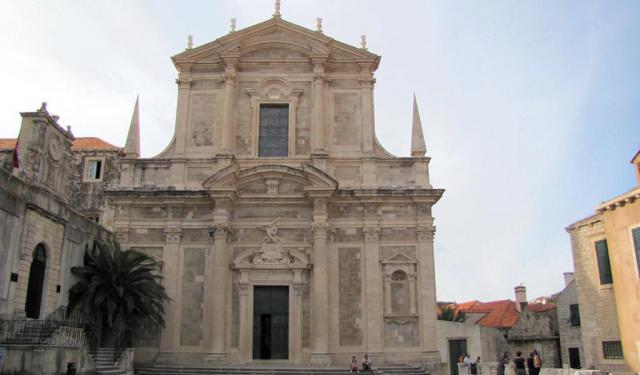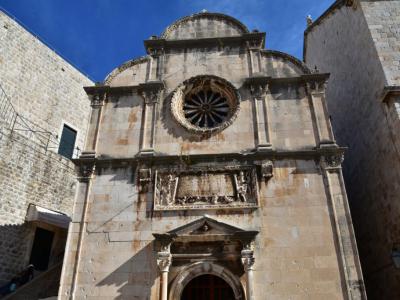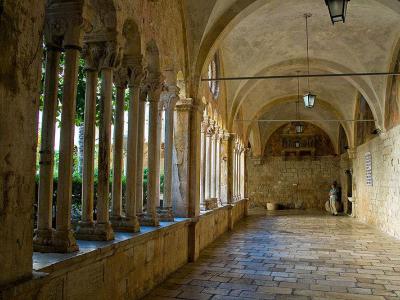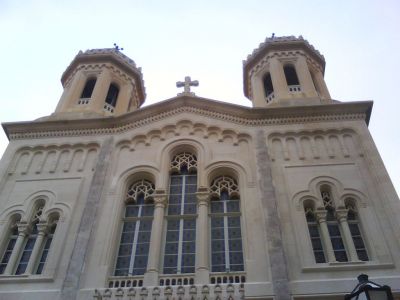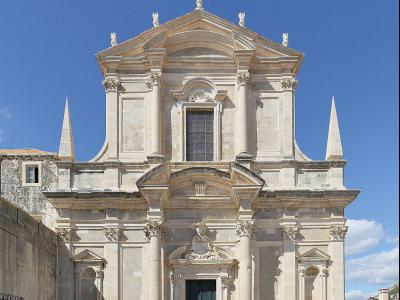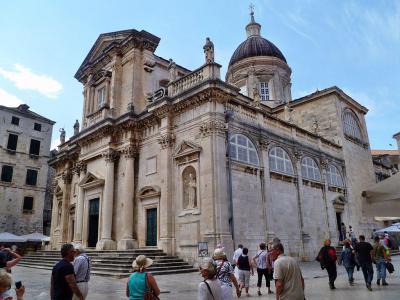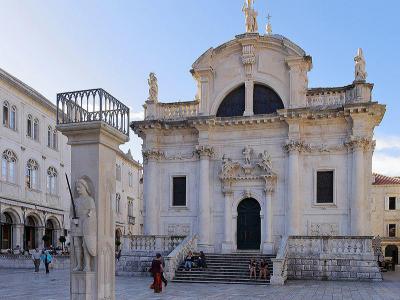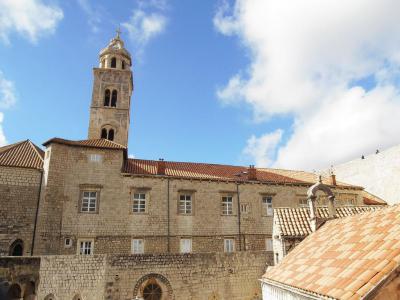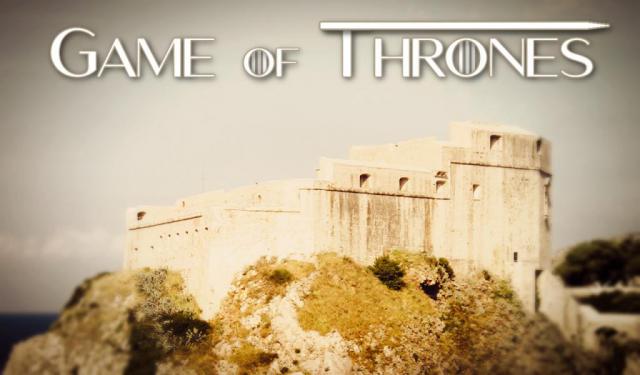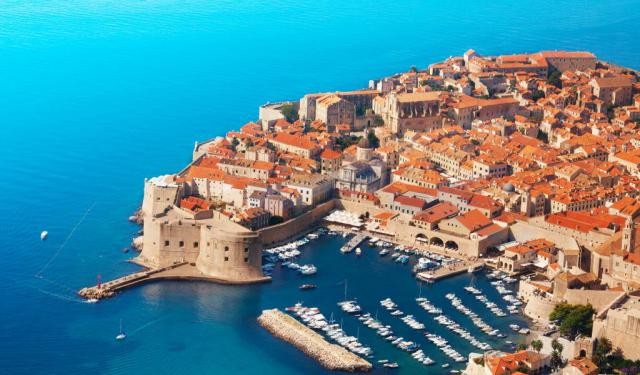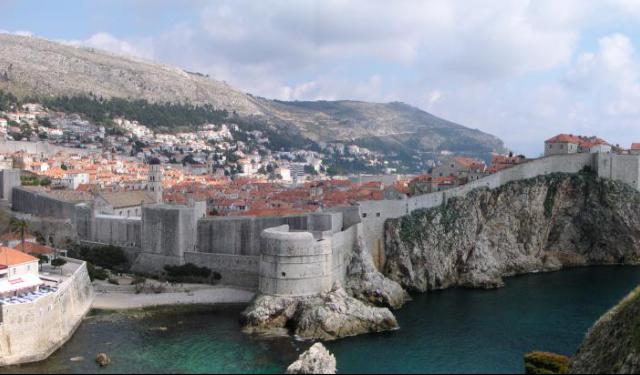Historical Churches (Self Guided), Dubrovnik
Throughout history, Dubrovnik’s citizens have had plenty of causes to ask God for help. And when they got it, they never forgot to express their gratitude. Oftentimes, it came in the form of newly built churches; hence an array of religious landmarks, some truly magnificent, found in the Old Town, constructed over the centuries.
One such architectural marvel is Saint Saviour's Church, characterized by its distinct Gothic style. Dating back to the first half of the 16th century, this church has played a significant role in Dubrovnik's religious life.
The Franciscan Monastery & Museum is a treasure trove of history and culture. The monastery was founded in the 14th century and houses a remarkable collection of art, manuscripts, and ancient pharmacy artifacts – a unique chance to explore Dubrovnik's intellectual and spiritual heritage.
The Serbian Orthodox Church, a serene and contemplative place of worship, showcases Byzantine-style architecture. It highlights the presence of the Orthodox community within the city.
Saint Ignatius Church is a Baroque masterpiece, featuring a grand exterior and a lavishly decorated interior. The church stands as a symbol of the city's enduring Catholic faith and architectural excellence.
The prominent Dubrovnik Cathedral and Treasury, also known as the Assumption Cathedral, commands attention with its stunning Baroque facade and impressive treasury containing religious relics.
Saint Blaise's Church is dedicated to the city's patron saint. A statue of the saint, also known locally as Sveti Vlaho, stands outside the church and is believed to protect the city from harm.
The Dominican Monastery and Museum is a serene oasis of spirituality and history. The monastery's architecture and art collections provide insight into Dubrovnik's medieval past.
Travelers who seek beauty and spirituality will find plenty of both in Dubrovnik. For a deeper understanding of the city's religious side, a visit to these historical temples is highly recommended.
One such architectural marvel is Saint Saviour's Church, characterized by its distinct Gothic style. Dating back to the first half of the 16th century, this church has played a significant role in Dubrovnik's religious life.
The Franciscan Monastery & Museum is a treasure trove of history and culture. The monastery was founded in the 14th century and houses a remarkable collection of art, manuscripts, and ancient pharmacy artifacts – a unique chance to explore Dubrovnik's intellectual and spiritual heritage.
The Serbian Orthodox Church, a serene and contemplative place of worship, showcases Byzantine-style architecture. It highlights the presence of the Orthodox community within the city.
Saint Ignatius Church is a Baroque masterpiece, featuring a grand exterior and a lavishly decorated interior. The church stands as a symbol of the city's enduring Catholic faith and architectural excellence.
The prominent Dubrovnik Cathedral and Treasury, also known as the Assumption Cathedral, commands attention with its stunning Baroque facade and impressive treasury containing religious relics.
Saint Blaise's Church is dedicated to the city's patron saint. A statue of the saint, also known locally as Sveti Vlaho, stands outside the church and is believed to protect the city from harm.
The Dominican Monastery and Museum is a serene oasis of spirituality and history. The monastery's architecture and art collections provide insight into Dubrovnik's medieval past.
Travelers who seek beauty and spirituality will find plenty of both in Dubrovnik. For a deeper understanding of the city's religious side, a visit to these historical temples is highly recommended.
How it works: Download the app "GPSmyCity: Walks in 1K+ Cities" from Apple App Store or Google Play Store to your mobile phone or tablet. The app turns your mobile device into a personal tour guide and its built-in GPS navigation functions guide you from one tour stop to next. The app works offline, so no data plan is needed when traveling abroad.
Historical Churches Map
Guide Name: Historical Churches
Guide Location: Croatia » Dubrovnik (See other walking tours in Dubrovnik)
Guide Type: Self-guided Walking Tour (Sightseeing)
# of Attractions: 7
Tour Duration: 1 Hour(s)
Travel Distance: 0.8 Km or 0.5 Miles
Author: emma
Sight(s) Featured in This Guide:
Guide Location: Croatia » Dubrovnik (See other walking tours in Dubrovnik)
Guide Type: Self-guided Walking Tour (Sightseeing)
# of Attractions: 7
Tour Duration: 1 Hour(s)
Travel Distance: 0.8 Km or 0.5 Miles
Author: emma
Sight(s) Featured in This Guide:
- Saint Saviour's Church
- Franciscan Monastery & Museum
- Serbian Orthodox Church
- Saint Ignatius Church
- Dubrovnik Cathedral and Treasury
- Saint Blaise's Church
- Dominican Monastery and Museum
1) Saint Saviour's Church
A devastating earthquake shook Dubrovnik on May 17, 1520. About twenty people were killed, and several buildings suffered heavy damage. The local senate of the Republic of Ragusa in Dubrovnik decided that while it was bad, it could have been worse. Out of gratitude for divine forbearance, they called for a small votive church to be built.
Architect Petar Andrijić, from the island of Korcula, received the commission in 1520. The church of Saint Saviour, dedicated to Jesus Christ, is located near Pile Gate. It has one nave and a Gothic ribbed vault ceiling. The slender side windows have Gothic pointed arches. Still, the front facade shows Renaissance motifs.
The three-leaf curved top of the upper level and the semicircular apse are certainly Renaissance elements. The main portal archway is flanked by slender columns supporting a triangular pediment. The entablature above bears an inscription in Latin expressing gratitude to God that the town had been spared even worse destruction.
In 1667 Dubrovnik was hit harder than ever by another quake. Around 5,000 people were killed, and much of the city was flattened. But Saint Saviour's Church was miraculously spared. Even its elegant rose window survived intact. The church remains today as it was in 1667, emerging unmarred amid disaster.
Architect Petar Andrijić, from the island of Korcula, received the commission in 1520. The church of Saint Saviour, dedicated to Jesus Christ, is located near Pile Gate. It has one nave and a Gothic ribbed vault ceiling. The slender side windows have Gothic pointed arches. Still, the front facade shows Renaissance motifs.
The three-leaf curved top of the upper level and the semicircular apse are certainly Renaissance elements. The main portal archway is flanked by slender columns supporting a triangular pediment. The entablature above bears an inscription in Latin expressing gratitude to God that the town had been spared even worse destruction.
In 1667 Dubrovnik was hit harder than ever by another quake. Around 5,000 people were killed, and much of the city was flattened. But Saint Saviour's Church was miraculously spared. Even its elegant rose window survived intact. The church remains today as it was in 1667, emerging unmarred amid disaster.
2) Franciscan Monastery & Museum (must see)
The document dating from 1235 mentions the Franciscan Monastery of Saint Thomas in the Pile suburb of Dubrovnik. The monastery was demolished and re-established within the city walls in 1317 under threats of war with King Uros II of Serbia. After the quake of 1667, the church was renovated in the Baroque style.
The monastery complex is grandiose. There are two cloisters. The upper one is Renaissance, with arches and semicircular vaults. The lower cloister is a combination of Romanesque and Gothic elements. A courtyard is surrounded by galleries of arches with double columns, having capitals with flora, fauna, and geometric embellishments.
The cloister was built by architect Mihoje Brajkov of Bar in the early 13th century. It has 120 columns and 12 enormous pilasters. A fountain and statue of Saint Francis is in the center of the cloister. The well-preserved Minor Friars Pharmacy has inventory from 1317. It has furnishings from Siena and Florence from the 15th and 16th centuries.
Other exhibits in the museum include presses, mortars, scales, a 14th-century still, and rare manuscripts. The Museum Library holds copies of medieval manuscripts, chorales, and highly valued paintings by forgotten masters. There is a 14th-century head relic of Saint Ursula and an assortment of ex-voto jewelry (a collection of one-of-a-kind and limited edition pieces designed by Elizabeth from antique elements).
The monastery complex is grandiose. There are two cloisters. The upper one is Renaissance, with arches and semicircular vaults. The lower cloister is a combination of Romanesque and Gothic elements. A courtyard is surrounded by galleries of arches with double columns, having capitals with flora, fauna, and geometric embellishments.
The cloister was built by architect Mihoje Brajkov of Bar in the early 13th century. It has 120 columns and 12 enormous pilasters. A fountain and statue of Saint Francis is in the center of the cloister. The well-preserved Minor Friars Pharmacy has inventory from 1317. It has furnishings from Siena and Florence from the 15th and 16th centuries.
Other exhibits in the museum include presses, mortars, scales, a 14th-century still, and rare manuscripts. The Museum Library holds copies of medieval manuscripts, chorales, and highly valued paintings by forgotten masters. There is a 14th-century head relic of Saint Ursula and an assortment of ex-voto jewelry (a collection of one-of-a-kind and limited edition pieces designed by Elizabeth from antique elements).
3) Serbian Orthodox Church
The Orthodox Church is a relatively new addition to the town, in terms of the local churches. It was constructed in 1865. The reason for this is that the local Serbians were not allowed to build a formal house of worship within the city limits until just a few years before the construction of the building. After that point, it has remained a house of prayer since. There are not as many members around anymore, as many of the Serbians left the area during the war of 1991.
Anyone of any denomination is allowed to purchase and light votive candles here. The local congregation is happy to share that honor.
Upon entrance, one will be able to see the many icons of Cretan and Byzantine origin here. Just next door, there is also a museum that displays even more of the old icons from the church. Go up to the second floor to see them.
The church is free to visit for anyone who wishes to come. The museum has a nominal entrance fee. The building is open seven days a week.
Anyone of any denomination is allowed to purchase and light votive candles here. The local congregation is happy to share that honor.
Upon entrance, one will be able to see the many icons of Cretan and Byzantine origin here. Just next door, there is also a museum that displays even more of the old icons from the church. Go up to the second floor to see them.
The church is free to visit for anyone who wishes to come. The museum has a nominal entrance fee. The building is open seven days a week.
4) Saint Ignatius Church (must see)
The Church of Saint Ignatius is located in Ruder Boskovic Field, reached by climbing steps designed after the famed Spanish Steps of Rome by architect Pietro Passalacqua. The church is built as a Jesuit church in the Roman Baroque style. It was completed in 1725 as a single-nave church and designed by Ignazio Pozzo.
Baroque frescoes inside showing the life of Saint Ignatius are the work of artist Gaetano Garcia. In 1885 a cave was created in the church dedicated to Our Lady of Lourdes. The cave was painted by the Jesuit master Antonio Moscheni. There are balconies and boxes on each side. Daylight through the stained-glass roof illuminates all within.
The facade is characterized by a High Baroque aesthetic. The central zone has free-standing columns and an ornate portal adorned with sculpted angels by architect Marino Groppelli. Next to the church is the Jesuit Collegium, built in 1662 and rebuilt in 1669-1725 after the devastating earthquake of 1667.
The Collegium was where the world-famous scholar Ruder Boskovic once taught. Today it is home to the Classical Gymnasium High School of Dubrovnik.
Baroque frescoes inside showing the life of Saint Ignatius are the work of artist Gaetano Garcia. In 1885 a cave was created in the church dedicated to Our Lady of Lourdes. The cave was painted by the Jesuit master Antonio Moscheni. There are balconies and boxes on each side. Daylight through the stained-glass roof illuminates all within.
The facade is characterized by a High Baroque aesthetic. The central zone has free-standing columns and an ornate portal adorned with sculpted angels by architect Marino Groppelli. Next to the church is the Jesuit Collegium, built in 1662 and rebuilt in 1669-1725 after the devastating earthquake of 1667.
The Collegium was where the world-famous scholar Ruder Boskovic once taught. Today it is home to the Classical Gymnasium High School of Dubrovnik.
5) Dubrovnik Cathedral and Treasury
In 1192, returning from the Third Crusade, Richard I of England survived a shipwreck off the island of Lokrum, near present-day Dubrovnik. As an offering of gratitude, Richard pledged to fund two churches. One of them was the Romanesque Cathedral of the Assumption of the Virgin Mary in Dubrovnik.
Richard's cathedral was destroyed in the earthquake of 1667. The Senate of Dubrovnik commissioned Italian architect Andrea Bufalini to rebuild. He developed a Baroque model church with a nave, two aisles, and a cupola. Friar Tommaso Napoli of Palermo added a cross vault and large windows on the upper level.
The portal on the facade is flanked by Corinthian columns. A central Baroque window is in a triangular gable with a balustrade and statues of saints. Niches hold statues of Saint Blaise and Saint Joseph with Child.
The interior has a high nave with two aisles separated by massive columns. There are three apses and a dome where the nave and transepts meet. The main altar has a polyptych by Titian from 1552 of the Assumption of Mary. The side altars hold paintings by both Italian and Dalmatian masters.
The Cathedral Treasury has 182 reliquaries with relics from the 11th to the 18th century. The reliquaries were created by local artists and masters from Byzantium, Venice, and Asia Minor. The featured relics are the gold-plated arm, leg, and skull of Saint Blaise. There is also a piece of the True Cross.
Richard's cathedral was destroyed in the earthquake of 1667. The Senate of Dubrovnik commissioned Italian architect Andrea Bufalini to rebuild. He developed a Baroque model church with a nave, two aisles, and a cupola. Friar Tommaso Napoli of Palermo added a cross vault and large windows on the upper level.
The portal on the facade is flanked by Corinthian columns. A central Baroque window is in a triangular gable with a balustrade and statues of saints. Niches hold statues of Saint Blaise and Saint Joseph with Child.
The interior has a high nave with two aisles separated by massive columns. There are three apses and a dome where the nave and transepts meet. The main altar has a polyptych by Titian from 1552 of the Assumption of Mary. The side altars hold paintings by both Italian and Dalmatian masters.
The Cathedral Treasury has 182 reliquaries with relics from the 11th to the 18th century. The reliquaries were created by local artists and masters from Byzantium, Venice, and Asia Minor. The featured relics are the gold-plated arm, leg, and skull of Saint Blaise. There is also a piece of the True Cross.
6) Saint Blaise's Church (must see)
Saint Blaise, "Sveti Vlaho" in Croatian, is known as a martyr, a protector of animals, and a miracle worker. The patron saint of Dubrovnik, he once saved the city from a Venetian attack in 971 through a vision to Stojko, a canon of Saint Stephen's Cathedral. Saint Blaise's Church in Luza Square is dedicated to him.
The church was built in 1715 by Venetian architect Marino Groppelli. The building was erected on the foundations of a medieval Romanesque church. The church has a single nave and a ground plan formed as a Greek Cross, a cross with arms of equal length. The apse is flanked by two sacristies. An oblong cupola is in the middle.
The lower facade is set off by four Corinthian columns. Two of the columns flank the main portal. The remaining two are at the edges of the facade. The upper level of the facade is a semicircular gable and a balustrade. A statue of Saint Blaise is at the top of the gable. The figures of Faith and Hope stand at the sides.
The barrel-vaulted interior is lavishly Baroque. There are Corinthian columns in the center. The main altar is of white and multi-colored marble. In a niche is a 15th-century Gothic-style statue of Saint Blaise. He holds a model of the previous Romanesque church destroyed by fire in the earthquake of 1667.
The church was built in 1715 by Venetian architect Marino Groppelli. The building was erected on the foundations of a medieval Romanesque church. The church has a single nave and a ground plan formed as a Greek Cross, a cross with arms of equal length. The apse is flanked by two sacristies. An oblong cupola is in the middle.
The lower facade is set off by four Corinthian columns. Two of the columns flank the main portal. The remaining two are at the edges of the facade. The upper level of the facade is a semicircular gable and a balustrade. A statue of Saint Blaise is at the top of the gable. The figures of Faith and Hope stand at the sides.
The barrel-vaulted interior is lavishly Baroque. There are Corinthian columns in the center. The main altar is of white and multi-colored marble. In a niche is a 15th-century Gothic-style statue of Saint Blaise. He holds a model of the previous Romanesque church destroyed by fire in the earthquake of 1667.
7) Dominican Monastery and Museum
The Dominican Monastery of Dubrovnik was established in 1315. Much of its original funding came from the local government. In addition, many local builders volunteered to help the Dominican Order to get established in the city. Sadly, the building sustained great damage during the 1667 earthquake and had to be rebuilt in places.
It is a classic example of a Gothic cloister adjoined by a working medieval well and an old bell tower that combines various architectural styles, from Romanesque to Baroque.
A special treasure of the Dominican monastery is the library with 216 incunabula, numerous illustrated manuscripts, a rich archive with precious manuscripts and documents, plus an extensive art collection. There is a statue of Saint Dominique, the founder of the Dominican Order. Also deserve mentioning are the newer Gothic arch and the statue of Christ.
The monastery campus is an example of one of the first multi-faceted construction projects in the city. Part of it is a cute little museum located off a small passageway behind the Sponza Palace, which, sadly, many visitors tend to miss. The museum is dedicated to preserving and displaying religious art from Dubrovnik. The collection includes some remarkably well-preserved paintings, church vessels, and triptychs, as well as a reliquary purportedly containing the skull of King Stephen I of Hungary.
Tip:
Buy the Dubrovnik one-day ticket that gives you access to several museums, including this monastery.
It is a classic example of a Gothic cloister adjoined by a working medieval well and an old bell tower that combines various architectural styles, from Romanesque to Baroque.
A special treasure of the Dominican monastery is the library with 216 incunabula, numerous illustrated manuscripts, a rich archive with precious manuscripts and documents, plus an extensive art collection. There is a statue of Saint Dominique, the founder of the Dominican Order. Also deserve mentioning are the newer Gothic arch and the statue of Christ.
The monastery campus is an example of one of the first multi-faceted construction projects in the city. Part of it is a cute little museum located off a small passageway behind the Sponza Palace, which, sadly, many visitors tend to miss. The museum is dedicated to preserving and displaying religious art from Dubrovnik. The collection includes some remarkably well-preserved paintings, church vessels, and triptychs, as well as a reliquary purportedly containing the skull of King Stephen I of Hungary.
Tip:
Buy the Dubrovnik one-day ticket that gives you access to several museums, including this monastery.
Walking Tours in Dubrovnik, Croatia
Create Your Own Walk in Dubrovnik
Creating your own self-guided walk in Dubrovnik is easy and fun. Choose the city attractions that you want to see and a walk route map will be created just for you. You can even set your hotel as the start point of the walk.
Game of Thrones Filming Sites Tour
Dubrovnik has no shortage of picturesque sights: colorful roofs with terracotta tiles, impressive stone architecture, high-rising cliffs, and a stunning Old Town wall overlooking the wild Adriatic. It is mostly for this reason that the city was chosen as the main filming location for King's Landing, a fictional city in the world-famous TV series "Game of Thrones." If you're a... view more
Tour Duration: 2 Hour(s)
Travel Distance: 2.7 Km or 1.7 Miles
Tour Duration: 2 Hour(s)
Travel Distance: 2.7 Km or 1.7 Miles
Dubrovnik Introduction Walking Tour
One of the most visited cities in Croatia – comfortably situated on the Adriatic coast in the south of the country, Dubrovnik is a major seaport and historical location packed with numerous monuments and points of interest. Since 1979, the city has been listed as the UNESCO World Heritage site.
The history of Dubrovnik dates back to the 7th century, when the town known as Ragusa was founded... view more
Tour Duration: 2 Hour(s)
Travel Distance: 1.8 Km or 1.1 Miles
The history of Dubrovnik dates back to the 7th century, when the town known as Ragusa was founded... view more
Tour Duration: 2 Hour(s)
Travel Distance: 1.8 Km or 1.1 Miles
City Walls Walking Tour
Gazing down at the fortified city, you see a treasure trove of Gothic and Renaissance churches, monasteries, Venetian palaces and ornately carved fountains. They’re all crammed together with shuttered apartments, hole-in-the-wall boutiques and outdoor restaurants and cafés.
There are three different entrances to the Dubrovnik walls. One is at Pile Gate, one is at Ploce Gate (near the... view more
Tour Duration: 2 Hour(s)
Travel Distance: 2.4 Km or 1.5 Miles
There are three different entrances to the Dubrovnik walls. One is at Pile Gate, one is at Ploce Gate (near the... view more
Tour Duration: 2 Hour(s)
Travel Distance: 2.4 Km or 1.5 Miles
The Most Popular Cities
/ view all
